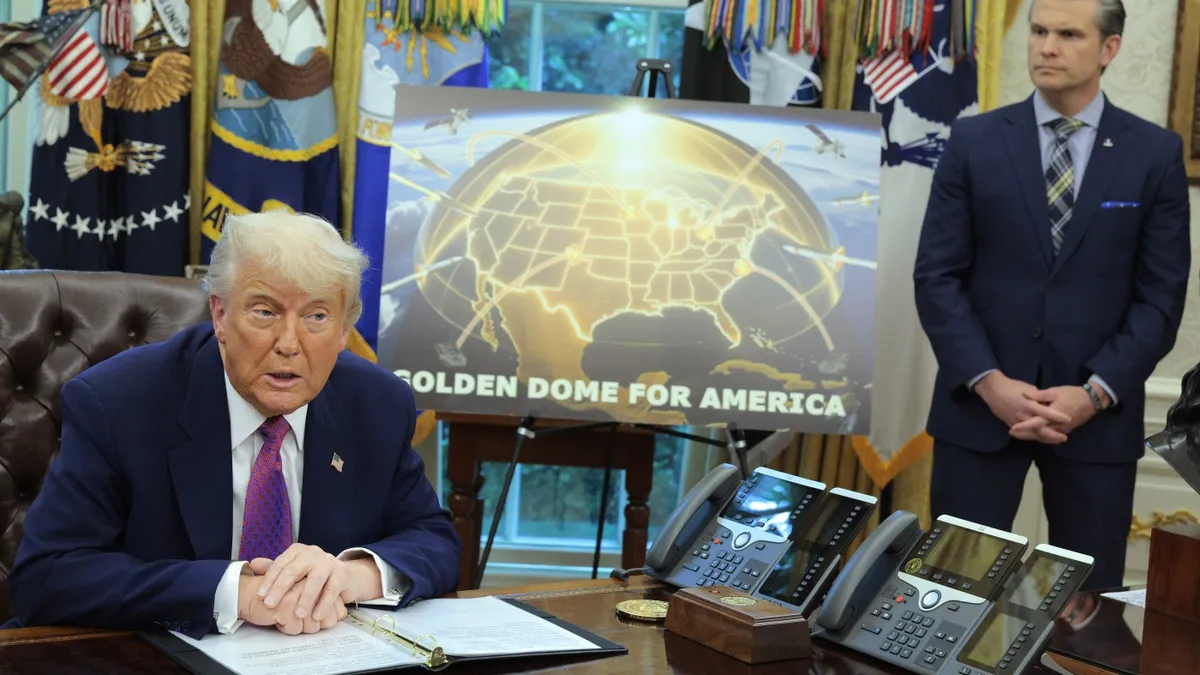
On Tuesday, President Trump announced an ambitious plan to protect the United States from missile attacks by introducing the Golden Dome initiative. This proposed defense system is designed to intercept missiles launched from anywhere around the globe, including those fired from outer space. Speaking to reporters in the Oval Office, Trump expressed his hope to complete the construction of the Golden Dome before the end of his term.
The estimated cost for the Golden Dome project is approximately $175 billion, with an initial funding request of $25 billion allocated in next year’s budget. The ambitious timeline and budget proposal reflect Trump’s determination to bolster national security through advanced missile defense technologies.
A critical component of the Golden Dome plan involves deploying both missile-sensing and missile-destroying satellites into orbit. This constellation of satellites is projected to number in the thousands and would enable rapid interception of missiles shortly after they launch from submarines or silos. The feasibility of such a wide-reaching network has evolved significantly in recent years, with advancements in space technology making this goal more attainable than ever.
Companies like SpaceX have demonstrated the potential for low-cost satellite launches with their Starlink project, which currently operates about 7,000 satellites in orbit. This scale is comparable to estimates for a practical space-based missile defense capability.
Experts like Tom Karako, director of the missile defense project at the Center for Strategic and International Studies, argue that the Golden Dome initiative is long overdue. Although Karako acknowledges that space-based interception of missiles is a complex challenge, he emphasizes that future conflicts may extend into space, necessitating robust defense capabilities. According to Karako, the Golden Dome could also support anti-satellite warfare if required, addressing the myriad threats present in space.
The idea of space-based missile defense has been a long-standing goal for U.S. policymakers. In 1983, former President Ronald Reagan introduced plans for a missile interception system aimed at countering threats from the Soviet Union. At that time, Reagan noted the formidable challenges ahead, predicting years, if not decades, of effort to realize such a vision. Although the Soviet Union eventually collapsed without Reagan's dream being fully realized, missile defense technologies have made notable advances since then.
The U.S. has effectively used systems like Patriot missiles to intercept shorter-range threats, and there are existing capabilities to counter medium- and intermediate-range ballistic missiles. However, intercepting Intercontinental Ballistic Missiles (ICBMs) remains a significant challenge. ICBMs launch from deep within enemy territory and travel at hypersonic speeds, complicating interception efforts.
Experts caution that while the Golden Dome aims to address these challenges, the technology needed for effective interception is still in question. Laura Grego, a physicist at the Union of Concerned Scientists, warns that the proposed system could be vulnerable to countermeasures, such as overwhelming the defense through clustered launches or directly attacking the satellites. Additionally, the U.S. has raised concerns about potential threats from nations like Russia, which may explore deploying nuclear warheads in orbit, capable of incapacitating components of the Golden Dome.
Emerging threats, including hypersonic missiles and Fractional Orbital Bombardment Systems, further complicate the landscape. A recent Defense Intelligence Agency report highlights the need for the Golden Dome to address these evolving dangers effectively.
The financial implications of the Golden Dome initiative remain uncertain. While President Trump estimates the project could be completed for $175 billion over three years, the Congressional Budget Office has projected costs ranging from $161 billion to $542 billion over two decades. Senator Tim Sheehy, R-Mont., indicated that the ultimate cost could reach into the trillions, which raises significant concerns regarding funding and resource allocation.
Given the potential for exorbitant costs, Laura Grego urges Congress to conduct thorough assessments before approving funding for the Golden Dome initiative. She points out that the history of missile defense is fraught with abandoned programs, and emphasizes the importance of scrutinizing the viability and practicality of such ambitious projects before committing taxpayer dollars.